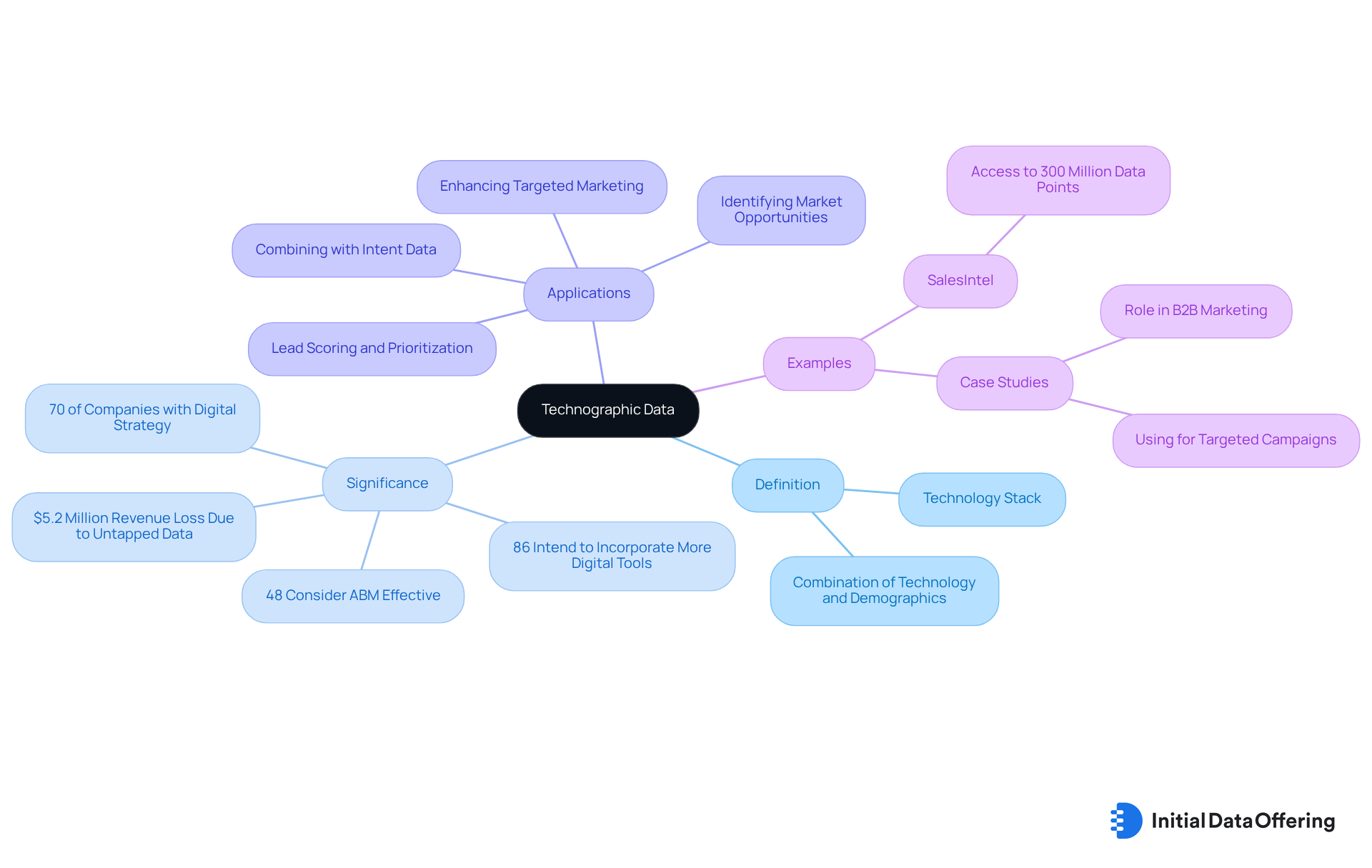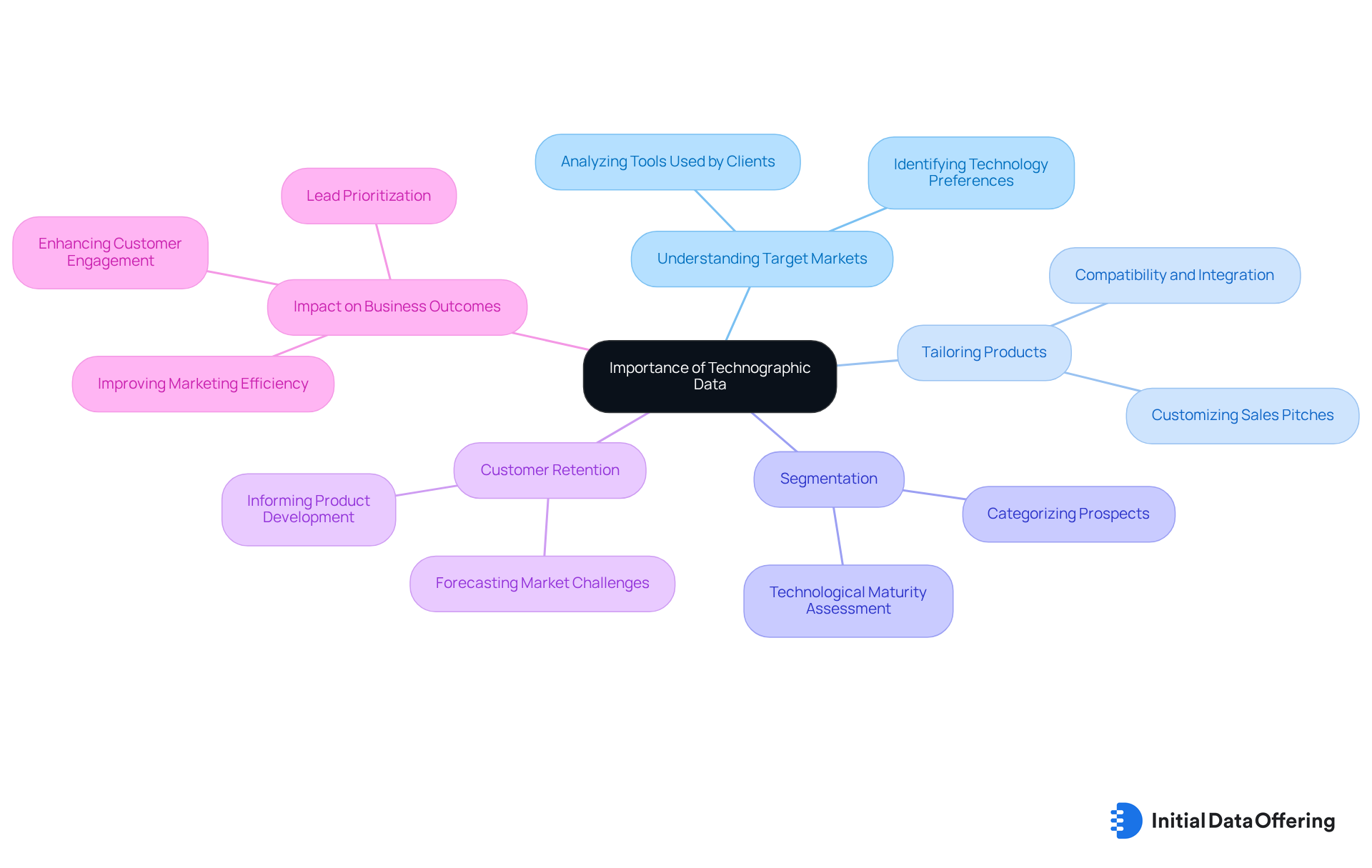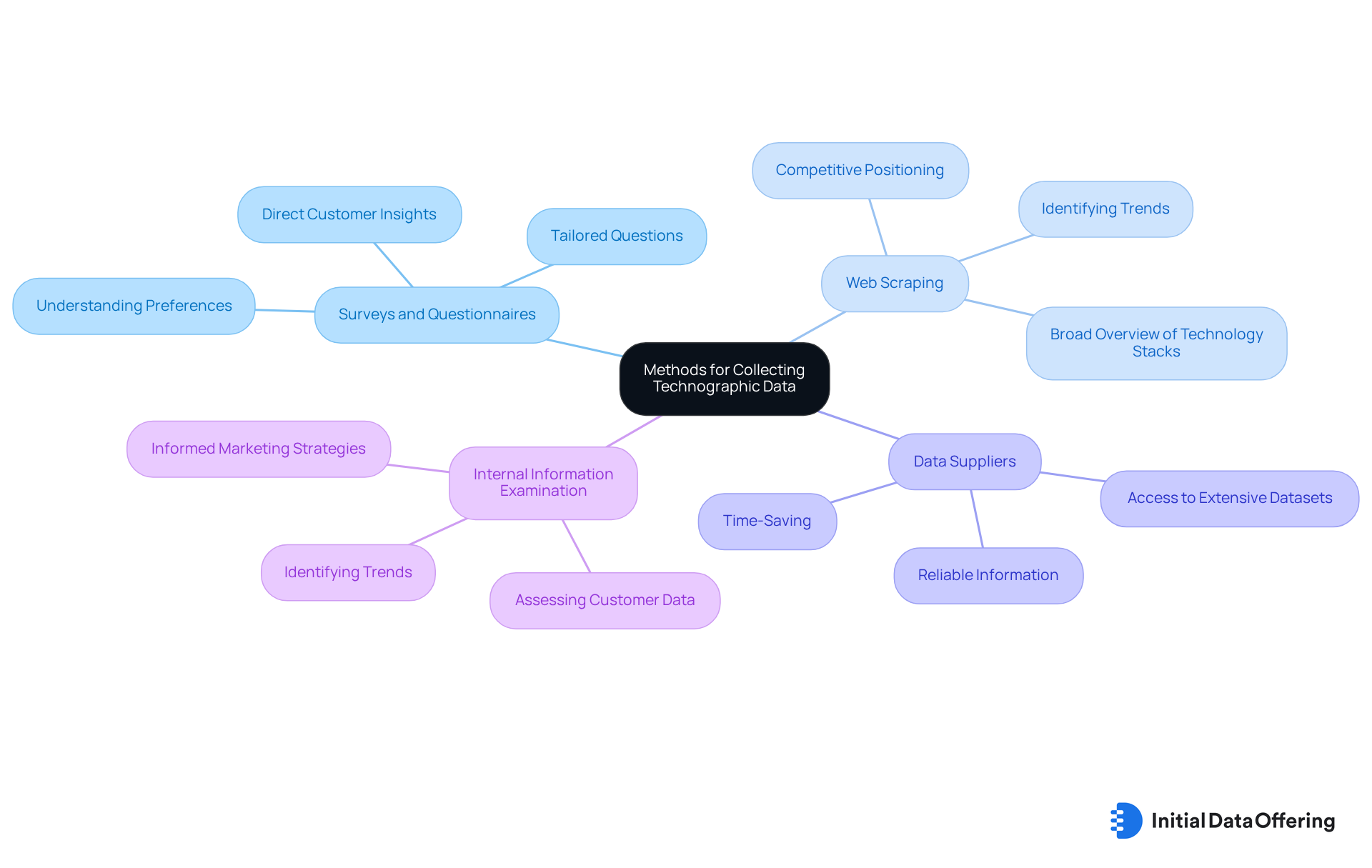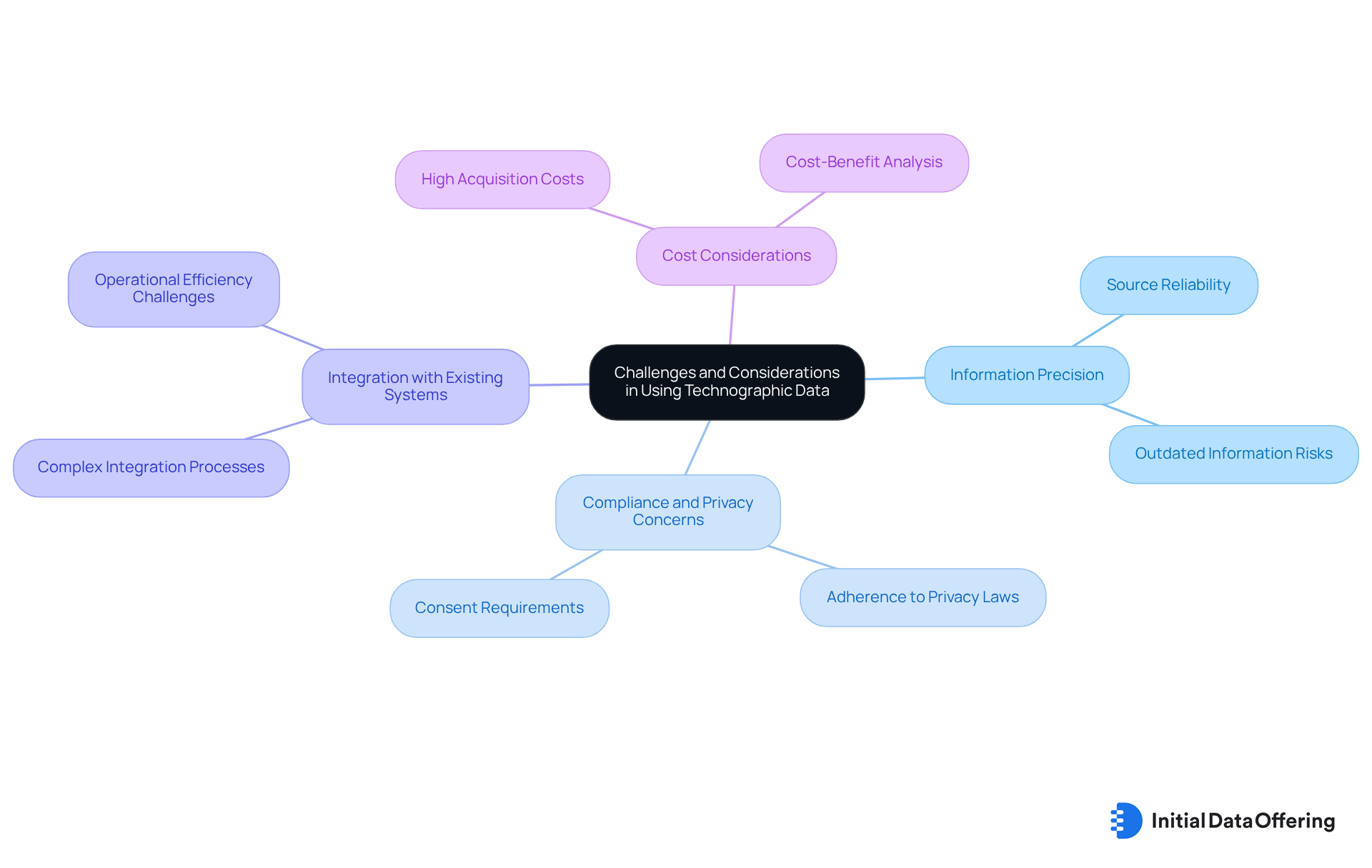Understanding Technographic Data: Definition and Importance

Understanding Technographic Data: Definition and Importance
Overview
Technographic data encompasses detailed information about the technology stack utilized by organizations, including hardware, software, and IT systems. This dataset is crucial for understanding market dynamics and tailoring effective marketing strategies. By analyzing technographic data, companies can gain insights into their competitors, allowing them to enhance targeted marketing efforts and improve customer engagement. Ultimately, leveraging this information leads to better business outcomes.
How can your organization utilize technographic data to stay ahead in the competitive landscape?
Introduction
Technographic data serves as a crucial lens through which organizations can analyze the technological landscape of their competitors and clients. This data encompasses the specific tools and systems employed by businesses, enabling companies to tailor their strategies effectively. By understanding these elements, organizations can enhance their marketing effectiveness and drive revenue growth. However, with the rapid evolution of technology and the increasing complexity of data collection, a pressing question arises: how can organizations effectively harness this valuable resource to stay ahead in a competitive marketplace?
Define Technographic Data: Understanding Its Core Concept
Technographic data encompasses the details that characterize the technology stack utilized by organizations, including the hardware, software, and IT systems they have implemented. This information provides specifics regarding the instruments and methods that firms employ to run their operations efficiently. By examining technographic data, companies can gain insights into their rivals' tool usage, identify potential clients, and tailor their marketing strategies accordingly. The term 'technographics' combines 'technology' and 'demographics,' emphasizing its focus on the technological aspects of organizations rather than traditional demographic factors.
The significance of in commerce is profound. For instance, 70% of companies either have a digital transformation strategy in place or are in the process of developing one, highlighting the increasing reliance on technology. Additionally, 48% of companies regard Account-Based Marketing (ABM) as a powerful marketing approach, illustrating how technographic data can enhance targeted marketing initiatives. Moreover, organizations forfeit an estimated $5.2 million in revenue due to unused information, underscoring the necessity of leveraging available insights. Firms such as SalesIntel exemplify the effective utilization of technology-related information, providing access to over 300 million data points that empower B2B marketers to focus their prospecting efforts effectively. This strategic approach not only boosts engagement but also drives revenue growth by customizing marketing campaigns based on the technographic data of the specific technologies utilized by prospects.
In today's competitive landscape, understanding technographic data is essential for organizations aiming to achieve a competitive edge. As Geoffrey Moore aptly states, 'information is absolutely essential to making wise organizational decisions.' By mapping hierarchies across purchaser information and integrating technographic data with intent data, companies can enhance lead scoring and prioritize high-potential candidates, ultimately improving sales efficiency and market positioning. Furthermore, the rising demand for information specialists highlights the critical role of technographic data in the current employment landscape, establishing it as a vital component for companies striving for success.

Explore the Importance of Technographic Data in Business Strategy
Technographic information is vital for corporate strategy as it enables organizations to better understand their target markets. By analyzing the tools that potential clients use, companies can tailor their products to meet specific needs. For example, if a company discovers that a target prospect employs a particular CRM system, it can adjust its sales pitch to emphasize compatibility and integration benefits. Furthermore, technology-related insights facilitate segmentation, allowing companies to categorize prospects based on their technological maturity and readiness for new solutions. This targeted strategy not only enhances marketing efficiency but also improves and conversion rates.
In a fragmented information marketplace, the significance of technographic data is heightened. Platforms such as Initial Data Offering (IDO) curate high-quality datasets that help organizations navigate this complexity. By connecting information providers with buyers, IDO enhances the availability and visibility of valuable insights, including technology-related knowledge. As noted by Ariana Shannon, "Companies that disregard the value and significance of these advanced intelligence capabilities risk lagging behind those that adopt them."
Moreover, technographic data can significantly impact customer retention and assist in identifying high-intent prospects. Companies can leverage this data to foresee market-driven challenges and inform product development decisions. By concentrating on the distinct technology stacks of their audience, companies can significantly enhance customer engagement and improve conversion rates, ultimately leading to better business outcomes. Case studies have shown that utilizing technological insights results in improved lead prioritization and more effective marketing strategies, highlighting its critical role in today's competitive landscape.

Identify Methods for Collecting Technographic Data
There are several methods for gathering technographic data, each possessing distinct features, advantages, and benefits. Understanding these approaches can significantly enhance your insights into the technographic data related to technology usage within your target audience. Common methods include:
- Surveys and Questionnaires: This method involves directly asking customers about their device usage, yielding valuable insights. Tailored questions can uncover specific details about the tools and systems in use, allowing for a deeper understanding of customer preferences and behaviors.
- Web Scraping: This approach entails to collect details about the tools companies are utilizing. It provides a broad overview of technology stacks across various organizations, enabling you to identify trends and competitive positioning in the market.
- Numerous companies specialize in collecting technographic data from various sources. Acquiring data from these suppliers can save time and ensure access to extensive datasets, allowing you to make informed decisions based on reliable information.
- Internal Information Examination: Companies can assess their own customer data, such as CRM entries and product usage statistics, to gain insights into the technologies their clients are utilizing. This method can help identify trends and inform future marketing strategies, ultimately driving better alignment with customer needs.
How can these methods be integrated into your current strategies to enhance your understanding of the market? By leveraging technographic data, you can make more informed decisions that align with your audience's technological landscape.

Examine Challenges and Considerations in Using Technographic Data
While the advantages of are significant, organizations must be aware of several challenges and considerations that could impact its effectiveness.
- Information Precision: The trustworthiness of technological information can vary greatly based on its source. Outdated or inaccurate information can lead to misguided strategies and wasted resources. It is crucial for organizations to assess the reliability of their data sources to ensure informed decision-making.
- Compliance and Privacy Concerns: Organizations must ensure that their information collection methods adhere to relevant privacy laws and regulations. This includes obtaining consent from individuals when necessary, which not only fosters trust but also protects the organization from potential legal repercussions.
- Integration with Existing Systems: Incorporating technology-related information into current marketing and sales systems can be complex. Companies may encounter difficulties in seamlessly integrating new information with existing processes and tools. A thoughtful approach to integration can enhance operational efficiency and data utilization.
- Cost Considerations: Acquiring high-quality technographic data from third-party providers can be expensive. Companies must weigh these costs against the potential benefits to determine the most effective approach for their needs. A careful cost-benefit analysis can guide organizations in making strategic investments in data acquisition.

Conclusion
Technographic data is a pivotal element in understanding the technological landscape within organizations, offering insights into the tools and systems they utilize. This data transcends traditional demographics, focusing instead on the technology stacks that shape operational efficiency and strategic decision-making. By leveraging technographic insights, companies can enhance their marketing strategies, target the right audiences, and ultimately drive better business outcomes.
The article highlights several key aspects of technographic data, including:
- Its definition
- Importance in business strategy
- Methods for collection
- Challenges organizations may face in its implementation
It emphasizes the growing reliance on technology in business operations, the need for tailored marketing approaches, and the critical role of accurate data in achieving competitive advantages. Furthermore, the discussion on data collection methods underscores the importance of integrating reliable technographic insights into existing systems to maximize their effectiveness.
In light of these insights, organizations are urged to recognize the significance of technographic data as a fundamental component of their strategic toolkit. Embracing this data not only fosters an improved understanding of customer needs but also positions companies to navigate the complexities of the modern market effectively. By prioritizing technographic insights, businesses can enhance customer engagement, drive innovation, and ensure long-term success in an increasingly technology-driven landscape.
Frequently Asked Questions
What is technographic data?
Technographic data refers to the details that characterize the technology stack utilized by organizations, including their hardware, software, and IT systems. It provides insights into the tools and methods companies use to operate efficiently.
How can companies use technographic data?
Companies can analyze technographic data to gain insights into their competitors' tool usage, identify potential clients, and tailor their marketing strategies accordingly.
What is the significance of technographic data in commerce?
Technographic data is significant as it highlights the increasing reliance on technology, with 70% of companies having a digital transformation strategy. It also enhances targeted marketing initiatives, as evidenced by 48% of companies recognizing Account-Based Marketing (ABM) as a powerful approach.
What are the financial implications of not leveraging technographic data?
Organizations may forfeit an estimated $5.2 million in revenue due to unused information, which underscores the importance of leveraging available insights.
How do companies like SalesIntel utilize technographic data?
Companies like SalesIntel provide access to over 300 million data points, allowing B2B marketers to effectively focus their prospecting efforts and customize marketing campaigns based on the technographic data of specific technologies used by prospects.
Why is understanding technographic data essential for organizations today?
Understanding technographic data is crucial for organizations seeking a competitive edge, as it enables better decision-making, enhances lead scoring, and prioritizes high-potential candidates, ultimately improving sales efficiency and market positioning.
What does the rising demand for information specialists indicate about technographic data?
The rising demand for information specialists highlights the critical role of technographic data in the employment landscape, establishing it as a vital component for companies striving for success.